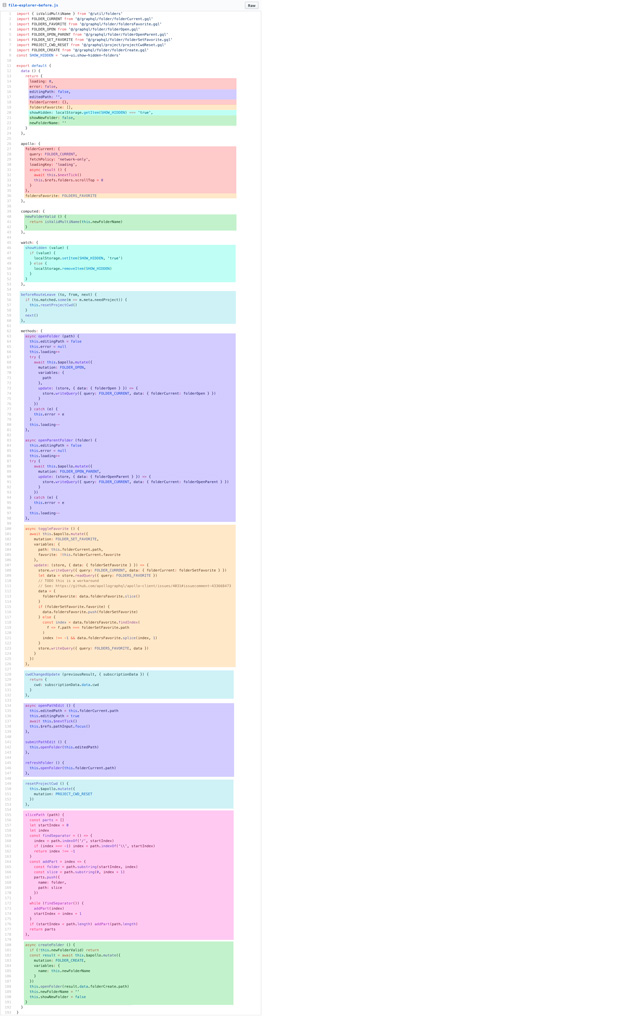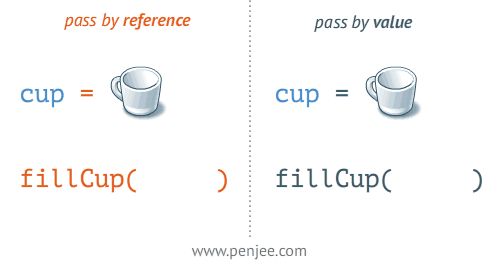您好,登錄后才能下訂單哦!
您好,登錄后才能下訂單哦!
這篇“Vue組合式API源碼分析”文章的知識點大部分人都不太理解,所以小編給大家總結了以下內容,內容詳細,步驟清晰,具有一定的借鑒價值,希望大家閱讀完這篇文章能有所收獲,下面我們一起來看看這篇“Vue組合式API源碼分析”文章吧。
在前面的課程中,我們都是采用 Options API(基于選項的 API ) 來寫一個組件的。下面是一個實例:
<template>
Count is: {{ count }}, doubleCount is: {{ doubleCount }}
<button @click="add">加</button>
</template>
<script>
export default {
data() {
return {
count: 0,
};
},
computed: {
doubleCount() {
return this.count * 2;
},
},
methods: {
add() {
this.count++;
}
}
}
</script>當要去理解一個組件時,我們更加關心的是:“這個組件是要干什么(即代碼背后的意圖)”,而不是:“這個組件用到了什么選項”。
Options API 撰寫出來的代碼自然采用了后者的表述方式,然而對前者的表述并不好。
在 Options API 中實際上形成了一種強制的約定:
props 里面設置接收參數
data 里面設置變量
computed 里面設置計算屬性
watch 里面設置監聽屬性
methods 里面設置事件方法
我們會發現: Options API 都約定了我們該在哪個位置做什么事,這在一定程度上也強制我們進行了代碼分割。這就為展示背后的邏輯關注點設置了障礙。我們必須不斷地在選項代碼塊之間“跳轉”,以找到與該關注點相關的部分。
尤其是在大型組件中,數據與方法會很多,而數據與其相關聯的方法就會被其他數據和方法分隔的很遠,往往很難被看出它們之間的關聯。

這是一個大型組件的示例,其中邏輯關注點是按顏色分組。
這種碎片化使得理解和維護復雜組件變得困難。選項的分離掩蓋了潛在的邏輯問題。此外,在處理單個邏輯關注點時,我們必須不斷地“跳轉”相關代碼的選項塊。
如果我們能夠將與同一個邏輯關注點相關的代碼配置在一起,這樣會更好。而這正是組合式 API 使我們能夠做到的。
Composition API:組合式 API;一組低侵入式的、函數式的 API,使得我們能夠更靈活地【組合】組件的邏輯。
這是有別于 Options API 的一種函數式 API。無需通過很多選項來完成業務邏輯,Composition API提供了一個setup函數,我們可以將data數據、計算屬性、方法等等,都放在setup函數中,這樣就可以對業務進行集中處理了。
采用Composition API來重寫上面的組件:
<template>
Count is: {{ state.count }}, doubleCount is: {{ state.doubleCount }}
<button @click="add">加</button>
</template>
<script>
import { reactive, computed } from "vue";
export default {
setup() {
const state = reactive({
count: 0,
doubleCount: computed(() => state.count * 2),
});
function add() {
state.count++;
}
return {
state,
add
}
}
}
</script>還有一個 setup 函數,setup 函數是一個新的組件選項。作為在組件內使用 Composition API 的入口點,如果 setup 返回一個對象,則對象的屬性將會被合并到組件模板的渲染上下文,我們就可以在模板里使用對應的屬性和方法。
setup 函數是一個新的組件選項,它是在組件內使用 Composition API 的入口點。它會在Vue實例創建完成前被調用。所以,setup函數中沒有this指針
<template>
<div></div>
</template>
<script>
export default {
setup() {
//這里書寫本地狀態(data數據)、計算屬性或方法等
console.log('setup函數');
}
}
</script>如果 setup 返回一個對象,則對象的屬性將會被合并到組件模板的渲染上下文,我們就可以在模板里使用對應的屬性和方法。所以,我們可以將本地狀態(data數據)、方法、計算屬性等寫在 setup 函數中。
<template>
Count is: {{ count }}
</template>
<script>
export default {
setup() {
let count = 10;
return {
count
}
}
}
</script>上面代碼中,在 setup 函數中聲明了一個 count 數據。然后使用 return 返回需要暴露的內容。運行之后可以看到:視圖能夠正確顯示count數據。
setup函數總結:
setup函數是Composition API 的入口點,是它的核心。
由于執行 setup 時,組件實例尚未被創建,因此在 setup 中不能使用 this。
setup中定義的東西必須要return出去,才能被使用或綁定視圖。
上面實例中,雖然視圖能夠顯示數據。但當改變數據時,視圖卻不會得到響應。
<template>
Count is: {{ count }}
<button @click="add">加</button>
</template>
<script>
export default {
setup() {
let count = 10;
function add(){
count++; //setup函數中沒有this指針
}
return {
count,
add
}
}
}
</script>原因很簡單,count只是聲明的一個普通數據,不具備響應功能。
在 Vue 3.0 中,我們可以通過一個 ref 函數來實現響應式數據監聽。ref 接受一個參數,并將其包裹在一個帶有 value 屬性的對象中返回,然后可以使用該 value 屬性訪問或更改響應式變量的值:
<template>
Count is: {{ count }}
<button @click="add">加</button>
</template>
<script>
//注意:要導入ref
import {ref} from 'vue';
export default {
setup() {
let count = ref(10); //count成為響應式數據。
function add(){
count.value++; //使用value屬性獲取響應數據
}
return {
count,
add
}
}
}
</script>為什么要將值封裝在一個對象中,看似沒有必要,但為了保持 JavaScript 中不同數據類型的行為統一,這是必須的。因為在 JavaScript 中,Number 或 String 等基本類型是通過值傳遞的,而不是通過引用傳遞的:

上面實例中,操作數據時需要使用 value 屬性,比較麻煩。
可以使用 reactive 與 toRefs 解決這個問題。首先使用 reactive 創建響應式對象,封裝數據。
<template>
<p>Count is: {{ state.count }}</p>
<button @click="add">加</button>
<p>{{ state.user.username }}</p>
</template>
<script>
//注意:要導入ref
import {reactive} from 'vue';
export default {
setup() {
//所有響應數據都聲明在這里,包括對象、數組
const state = reactive({
count: 10,
user:{
userId: 1,
username: '張三'
}
})
function add(){
state.count++; //這里可以不使用value了
}
return {
state,
add
}
}
}
</script>此時不用使用 value 屬性了。
但是因為只有state是響應式數據,而state中的那些數據還不是響應式的。所以在視圖訪問數據時都需要使用 state 作為前綴才可以。這就比較麻煩了。
此時我們可以使用 toRefs 進行優化。toRefs可以將state中的每一個數據進行展開,且都包裝成響應數據。這樣視圖層就可以直接使用了。
<template>
<p>Count is: {{ count }}</p>
<button @click="add">加</button>
<p>{{ user.username }}</p>
</template>
<script>
//注意:要導入ref
import {reactive, toRefs} from 'vue';
export default {
setup() {
//所有響應數據都聲明在這里,包括對象、數組
const state = reactive({
count: 10,
user:{
userId: 1,
username: '張三'
}
})
function add(){
state.count++; //這里可以不使用value了
}
return {
...toRefs(state), //這里使用使用 ...toRefs(state)
add
}
}
}
</script>在返回時使用 ...toRefs(state) ,這樣視圖層就可以不使用 state 前綴了。
為什么要使用 ... 參數擴展運輸符呢?因為toRefs(state) 將state對象展開,并包裝成多個響應數據。
<template> <p>Count is: {{ count }}</p> <p>doubleCount is: {{ doubleCount }}</p> <button @click="add">加</button> <p>{{ user.username }}</p></template><script>//注意:要導入refimport { reactive, toRefs, computed } from "vue";export default { setup() { //所有響應數據都聲明在這里,包括對象、數組 const state = reactive({ count: 10, user: { userId: 1, username: "張三", }, doubleCount: computed(() => { //使用computed函數 return state.count * 2; }), }); function add() { state.count++; //這里可以不使用value了 } return { ...toRefs(state), add, }; },};</script>首先要import導入computed。 在reactive({})中聲明computed即可。
到現在為止,響應式數據就都可以處理了。
2.5.watch的用法
<template> <div> {{ num }} <button @click="add">加</button> </div></template><script>import { reactive, toRefs, watch } from "vue";export default { setup() { const state = reactive({ num: 0, }); watch(state,(newValue, oldValue) => { console.log(newValue, oldValue); } ); function add() { state.num++; } return { ...toRefs(state), add, }; },};</script>使用watch函數來進行數據監聽。watch函數有兩個參數。 第一個參數:要監聽的數據。 第二個參數:觸發監聽時的處理函數(包括newValue, oldValue)
上面實例中直接監聽state響應對象。但我們知道,在state中會有很多數據,如果只想監聽其中的某個數據,就需要換一種寫法:
watch(() => state.num,(newValue, oldValue) => { console.log(newValue, oldValue);});第一個參數要寫成函數返回值的形式,這樣就能監聽state響應對象中的某個數據了。
2.6.setup()參數
setup() 函數有兩個參數:props 和 context。
為什么要有這兩個參數呢?我們知道父子組件之間是可以傳值。但是現在我們的業務邏輯都寫在setup函數中,而setpu中沒有this指針,那么就只能靠這兩個參數來進行傳遞了。
props:父組件向子組件傳值的參數。 context:子組件向父組件傳值的參數。
2.6.1.props參數
setup() 函數的 props 是父組件向子組件傳值的參數。
在components文件夾中創建子組件(Hello.vue):
<template> <div>我是子組件</div></template><script>export default { setup(props, context) { console.log(props.msg) }, props: { msg: String, },};</script><style></style>父組件(HomeView.vue):
<template> <div> <Hello msg="hello"></Hello> </div></template><script>import Hello from '../components/Hello.vue'import { reactive, toRefs, computed } from "vue";export default { setup() { const state = reactive({ }); return { ...toRefs(state), }; }, components:{ Hello }};</script>注意,要先import導入子組件,然后使用components掛載子組件。
2.6.2.context參數
setup() 函數的 context 是子組件向父組件傳值的參數。
子組件(Hello.vue):
<template> <div> <div>我是子組件</div> <button @click="send">給父組件發數據</button> </div></template><script>export default { setup(props, context) { function send() { context.emit("childmsg", "hello world!"); } return { send, }; }, props: { msg: String, },};</script><style></style>父組件(HomeView.vue):
<template> <div> <Hello msg="hello" @childmsg="get"></Hello> <p>我是父組件,接受子組件傳的值:{{welcome}}</p> </div></template><script>import Hello from '../components/Hello.vue'import { reactive, toRefs, computed } from "vue";export default { setup() { //所有響應數據都聲明在這里,包括對象、數組 const state = reactive({ welcome: '' }); function get(param) { state.welcome = param; } return { ...toRefs(state), get }; }, components:{ Hello }};</script>三.Composition API的使用
下面我們會將前面學過的知識點都改寫為Composition API的形式。而且,Vue3兼容Options API和Composition API兩種寫法。所以這兩種寫法都要會。
3.1.provide與inject的使用
我們學過provide與inject可用于多級組件直接傳遞數據,下面學習provide與inject在Composition API中的使用。
創建孫子組件(SubHello.vue)
<template> <div> <div>我是孫組件</div> </div></template><script>import { inject } from "vue";export default { setup(props, context) { console.log(inject('msg')) return {}; }};</script>在孫子組件中import導入inject,并使用inject接收上級組件的傳值。
在子組件(Hello.vue)中使用孫子組件
<template> <div> <div>我是子組件</div> <SubHello></SubHello> </div></template><script>import SubHello from './SubHello.vue'export default { setup(props, context) { return {}; }, components:{ SubHello }};</script><style></style>在父組件中使用provide給多級組件傳值
<template> <div> <Hello></Hello> </div></template><script>import Hello from "../components/Hello.vue";import { provide } from "vue";export default { setup() { provide('msg','hello'); }, components:{ Hello }};</script>注意,由于父組件向孫子組件傳遞數據是單向的,所以孫子組件不能修改傳遞的值。如果子組件
3.2.vue生命周期的用法
在 setup () 內部調用生命周期鉤子:
選項式API
setup () 內部調用生命周期鉤子
beforeCreate()
setup()
created()
setup()
beforeMount()
onBeforeMount()
mounted()
onMounted()
beforeUpdate()
onBeforeUpdate()
updated()
onUpdated()
beforeUnmount()
onBeforeUnmount()
unmounted()
onUnmounted()
注意:在Composition API中沒有beforeCreate()和created()這里兩個聲明周期函數了,統一使用setup()。
實例:
<template> <div> {{ num }} <button @click="add">加</button> </div></template><script>import { reactive,toRefs,onBeforeMount,onMounted,onBeforeUpdate,onUpdated,onBeforeUnmount,onUnmounted } from "vue";export default { setup() { const state = reactive({ num: 1, }); function add() { state.num++; } onBeforeMount(() => { console.log("DOM掛載前!"); }); onMounted(() => { console.log("DOM掛載后!"); }); onBeforeUpdate(() => { console.log("數據更新前!"); }) onUpdated(() => { console.log("數據更新后!"); }) onBeforeUnmount(() => { console.log("實例卸載前!"); }) onUnmounted(() => { console.log("實例卸載后!"); }) return { ...toRefs(state), add, }; },};</script>3.3.編程式路由的使用
下面學習如何在Composition API中使用路由。
打開App.vue組件,這里已經有了路由。當然,是使用router-link標簽來實現的。現在我們將它改成編程式路由。
<template> <nav> <!-- <router-link to="/">Home</router-link> | <router-link to="/about">About</router-link> --> <button @click="toHome">Home</button> <button @click="toAbout">About</button> </nav> <router-view /></template><script>import { useRouter } from "vue-router";export default{ setup() { const router = useRouter(); function toHome(){ router.push('/'); } function toAbout(){ router.push({path:'/about',query:{name:'zhangsan'}}); } return { toHome, toAbout } },}</script>先import導入useRouter模塊。 通過useRouter模塊獲取router對象。以后的路由寫法就與前面所學一樣了。
下面是獲取路由參數,打開AboutView.vue文件
<template> <div> </div></template><script>import { useRoute } from "vue-router";export default { setup(){ const route = useRoute(); console.log(route.query.name); }}</script>通過同樣的方式獲取route對象后就可以獲取路由參數了。
3.4.Vuex的使用
下面學習如何在Composition API中使用Vuex。
<template> <div> </div></template><script>import { useStore } from "vuex";export default { setup() { const store = useStore(); console.log(store.state.num); console.log(store.getters.newnum); }};</script>先import導入useStore模塊。 通過useStore模塊獲取store對象。就可以通過store對象獲取Vuex中的所有數據了。
3.5.獲取DOM的使用
前面我們知道在Vue中,可以使用ref來獲取DOM對象。下面學習如何在Composition API中使用ref。
<template> <div ref="myRef">獲取單個DOM元素</div></template><script>import { ref, onMounted } from 'vue';export default { setup() { const myRef = ref(null); //ref(null)是一個固定的寫法 onMounted(() => { console.dir(myRef.value); }); return { myRef }; }};</script>在HTML標簽中使用 ref 屬性標識一個DOM對象。 需要 import 導入 ref 對象。 使用 const myRef = ref(null); 的方式獲取包裝好的DOM對象,命名為HTML中的 ref 屬性名。并且此數據需要暴露出去。 使用 value 屬性即可獲取 DOM對象。
四.使用Composition API重寫todoList AddNew組件
<template> <div> <input type="text" v-model="newItem" /> <button @click="handleAdd">添加</button> </div></template><script>import {reactive, toRefs} from 'vue';export default { setup(props, context){ const state = reactive({ newItem: "" }) function handleAdd() { if (state.newItem == "") { alert("不能為空"); return; } //注意:這里使用setup參數context來出發父組件事件 context.emit("submitNewItem", state.newItem); state.newItem = ""; } return { ...toRefs(state), handleAdd } }}</script>TheList組件
<template> <ol> <li v-for="(item, index) in list" :key="index" @click="judgeItem(index)"> {{ item }} </li> </ol></template><script>export default { setup(props, context) { //這里分別使用了setup的兩個參數 function judgeItem(index) { if (props.listType) { context.emit("handleDelete", index); } else { context.emit("handleJudge", index); } } return { judgeItem }; }, props: { list: { type: Array, required: true, }, listType: { type: Boolean, default: false, }, },};</script>TodoList組件
<template> <div> <h2>todoList</h2> <AddNew @submitNewItem="addNewItem"></AddNew> <TheList :list="todoList" @handleJudge="toDone"></TheList> <hr /> <TheList :list="doneList" :listType="true" @handleDelete="toDelete"></TheList> </div></template><script>import AddNew from "../components/AddNew.vue";import TheList from "../components/TheList.vue";import {reactive, toRefs} from 'vue';export default { setup(){ const state = reactive({ todoList: [], //待辦事項 doneList: [] //完成事項 }) function addNewItem(newItem){ state.todoList.push(newItem); } function toDone(index){ state.doneList.push(state.todoList.splice(index,1)[0]); } function toDelete(index){ state.doneList.splice(index,1); } return { ...toRefs(state), addNewItem, toDone, toDelete } }, components: { AddNew, TheList, },};</script>五.setup語法糖
在Composition API中,在setup函數中聲明的數據、函數等內容,都需要通過 return 對外暴露,才能被組件的視圖模板(template)使用,這就造成了書寫上的不方便。于是,Vue官方又給我們推出了一個新的setup語法糖。
使用setup語法糖,就可以不用寫setup函數了。并且,數據和函數也不用返回,組件也不需要注冊了。
5.1.setup語法糖的基本結構
<template></template><script setup>//此處直接寫setup函數中的內容</script><style></style>
在script標簽中使用setup屬性即可。 運行時,script標簽中的內容會被重新編譯成 setup() 函數的形式。 而且,聲明的數據、函數不需要通過 return 暴露,即可被 template所使用
5.2.響應數據的使用
<template> <div> <p>{{ num }}</p> <button @click="add">加</button> </div></template><script setup>let num = 10;//const num = 10;//由于num不是響應數據,所以改變num是無效的。const add = ()=>{ alert("觸發了此方法"); num++;}</script>直接聲明的數據不是響應式的,數據改變時不會響應到視圖模板中。
<template> <div> <p>{{ num }}</p> <p>{{ dept.deptno }},{{ dept.dname }},{{ dept.loc }}</p> <ul> <li v-for="user in userArr" :key="user.userId"> {{user.userId}},{{user.userName}},{{user.userAge}} </li> </ul> <button @click="add">加</button> </div></template><script setup>import { reactive, ref } from "vue";const num = ref(10);const dept = reactive({ deptno: 20, dname: "技術部", loc: '沈陽市',});const userArr = ref([ { userId: 100, userName: "張三", userAge: 25, }, { userId: 101, userName: "李四", userAge: 26, }, { userId: 102, userName: "王五", userAge: 27, },]);const add = () => { num.value++; //注意:要使用value屬性獲取 dept.deptno++; //userArr.value[0].userAge++; userArr.value = [];}</script>ref 和 reactive 都可以做響應式數據,它們的區別如下:
reactive:用于定義引用類型。只能修改數據,不能改變其引用。 ref:用于定義基本類型和引用類型。可以修改數據,也可以改變其引用。 在方法中修改數據時需要使用 value屬性。因為,Ref的本質是通過Reactive創建的,Ref(10) 就相當于:Reactive({value:10});在視圖模板調用可以省略value屬性的書寫。
5.3.其它語法的使用
下面例子演示了computed計算屬性、watch監聽、生命周期函數的使用。
<template> <div> {{ num }} {{ newNum }} <button @click="add">add</button> </div></template><script setup>import { ref, computed, watch, onMounted } from 'vue';const num = ref(10);const newNum = computed(() => { return num.value*2;})const add = ()=>{ num.value++;}watch(num,(newValue,oldValue)=>{ console.log(newValue,oldValue);})//生命周期函數onMounted(() => { console.log("DOM掛載后!");});</script>5.4.引入組件的使用
引入的組件不必注冊,可以直接使用。
<template> <div class="home"> <HelloWorld msg="Welcome to Your Vue.js App"/> </div></template><script setup>// @ is an alias to /srcimport HelloWorld from '@/components/HelloWorld.vue'</script>
5.5.父子組件傳值的使用 5.5.1.defineProps的使用
defineProps用于父組件向子組件傳值。
父組件
<template> <div class="home"> <HelloWorld msg="Welcome to Your Vue.js App" :num="num"/> </div></template><script setup>// @ is an alias to /srcimport HelloWorld from '@/components/HelloWorld.vue'const num = 20</script>
子組件
<template> <div class="hello"> <h2>{{ msg }},{{ num }}</h2> </div> </template><script setup>//const myProps = defineProps(['msg','num']);const myProps = defineProps({ msg:{ type: String }, num:{ type: Number, required: true }});</script><style scoped></style>defineProps也可以有數組形式和對象形式兩種寫法。
5.5.2.defineEmits的使用
defineEmits用于子組件向父組件傳值。
父組件
<template> <div class="home"> <HelloWorld msg="Welcome to Your Vue.js App" :num="num" @childmsg="get"/> </div></template><script setup>// @ is an alias to /srcimport HelloWorld from '@/components/HelloWorld.vue'const num = 20;const get = (value) => { console.log(value)}</script>子組件
<template> <div class="hello"> <h2>{{ msg }},{{ num }}</h2> <button @click="send">給父組件傳值</button> </div> </template><script setup>const myProps = defineProps(['msg','num']);const emit = defineEmits(['childmsg']);const send = () => { emit('childmsg','子組件向父組件傳的值');}</script><style scoped></style>六.使用setup語法糖重寫todoList AddNew組件
<template> <div> <input type="text" v-model="newItem" /> <button @click="handleAdd">添加</button> </div></template><script setup>import { ref } from "vue";const newItem = ref("");const emit = defineEmits(["submitNewItem"]);const handleAdd = () => { if (newItem.value == "") { alert("不能為空"); return; } emit("submitNewItem", newItem.value); newItem.value = "";};</script>TheList組件
<template> <ol> <li v-for="(item, index) in list" :key="index" @click="judgeItem(index)"> {{ item }} </li> </ol></template><script setup>const emit = defineEmits(['handleDelete','handleJudge']);const judgeItem = (index) => { if (myProps.listType) { emit("handleDelete", index); } else { emit("handleJudge", index); }};const myProps = defineProps({ list: { type: Array, required: true, }, listType: { type: Boolean, default: false, },});</script>TodoList組件
<template> <div> <h2>todoList</h2> <AddNew @submitNewItem="addNewItem"></AddNew> <TheList :list="todoList" @handleJudge="toDone"></TheList> <hr /> <TheList :list="doneList" :listType="true" @handleDelete="toDelete" ></TheList> </div></template><script setup>import AddNew from "../components/AddNew.vue";import TheList from "../components/TheList.vue";import { reactive } from "vue";const todoList = reactive([]); //待辦事項const doneList = reactive([]); //完成事項const addNewItem = (newItem) => { todoList.push(newItem);}const toDone = (index) => { doneList.push(todoList.splice(index, 1)[0]);}const toDelete = (index) => { doneList.splice(index, 1);}</script>以上就是關于“Vue組合式API源碼分析”這篇文章的內容,相信大家都有了一定的了解,希望小編分享的內容對大家有幫助,若想了解更多相關的知識內容,請關注億速云行業資訊頻道。
免責聲明:本站發布的內容(圖片、視頻和文字)以原創、轉載和分享為主,文章觀點不代表本網站立場,如果涉及侵權請聯系站長郵箱:is@yisu.com進行舉報,并提供相關證據,一經查實,將立刻刪除涉嫌侵權內容。